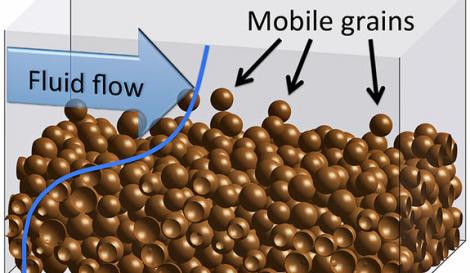Corey O'Hern Wins DoD Grant to Study Grain Movement

For his work on how sediment moves, Corey O’Hern, associate professor of mechanical engineering & materials science, physics, and applied physics, has been awarded a Defense University Research Instrumentation Program (DURIP) grant from the U.S. Department of Defense (DoD).
 DURIP grants fund state-of-the-art equipment for cutting edge research at universities. The DoD recently announced awards to 175 university researchers at 91 institutions in 36 states, totaling $53 million. O’Hern, the only Yale faculty member to receive a DURIP this year, is developing a clearer picture of how sediment beds evolve and how to control those changes.
DURIP grants fund state-of-the-art equipment for cutting edge research at universities. The DoD recently announced awards to 175 university researchers at 91 institutions in 36 states, totaling $53 million. O’Hern, the only Yale faculty member to receive a DURIP this year, is developing a clearer picture of how sediment beds evolve and how to control those changes.
Many factors play a role in how flowing water causes a gravel bed to evolve over time or after a flood event. O’Hern has developed new computational models to better understand how the size and shape of grains affects these changes.
The difference in grain sizes plays a big role. Depending on the circumstances, O’Hern explains, a number of things can happen. Sometimes the water flow can carry away nearly all the small grains, leaving only the large ones. That’s known as “armoring” of the grain bed, and it means that the bed will remain in that state for a long time. Other times, the flow is just strong enough to agitate the bed and shake the smaller grains to the bottom as they fall between the larger grains (similar to shaking a jar of different-sized marbles). There’s also the possibility that gravity will win out and send the larger, heavier grains to the bottom.
O’Hern’s computational models are designed to determine under what conditions each of these mechanisms occurs. By considering the fluid flow rate, mass, size, and shape of the grains, O’Hern said they can predict the steady-state size distribution of the bed. Unlike previous computer models used to study the phenomenon, those developed by O’Hern take into account the wide range of shapes and sizes of the grains that typically make up gravel-bedded rivers.
O’Hern’s computational models that capture the grain-scale structure of riverbeds require an increase in computer power. The DURIP grant will provide funding for a large cluster of graphics processing units (GPU), a type of computer chip that is used to render graphics for video games and can perform simple mathematical operations very quickly.
As part of the project, O’Hern will develop strategies to prevent bed evolution. “If you have a bed that’s prone to transport large amounts of sediment, maybe you could seed the bed with engineered grains that could prevent erosion of certain grain sizes and shapes,” he said.
Understanding the changes in fluid-driven granular beds could have a number of uses for the military and Army Corp of Engineers. For instance, it could help control the erosion near pilings of bridges and other large structures.
“And if we better understand the erosion process that forms the bed, we could better plan land use and management, especially in arid areas,” O’Hern said.

